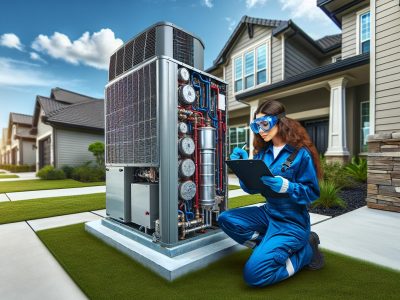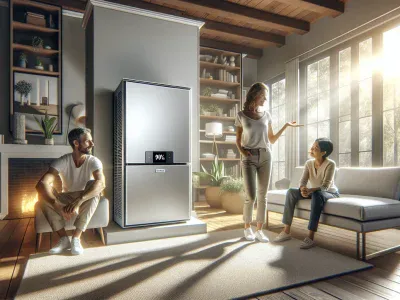Difference Between HVAC and Heat Pump: Key Features, Efficiency, and Costs Explained
Picture stepping into your home on a sweltering summer day or a freezing winter night, expecting perfect comfort at the touch of a button. But what’s working behind the scenes to keep your space just right? Two common systems—HVAC and heat pumps—often play this critical role, yet many people don’t fully understand how they differ.
While both are designed to regulate your indoor climate, their functions, efficiency, and mechanisms vary in surprising ways. Whether you’re upgrading your system or simply curious about how they work, knowing these differences can help you make smarter decisions for your home and budget. So what sets them apart? Let’s jump into the fascinating distinctions that could change how you think about heating and cooling forever.
Understanding HVAC Systems
HVAC systems manage heating, ventilation, and air conditioning to ensure indoor comfort. They combine multiple components to regulate temperature, airflow, and air quality efficiently.
Components Of HVAC Systems
HVAC systems consist of several critical components. The furnace or boiler provides heat during colder months by burning fuel or using electricity. Air conditioners cool indoor spaces by extracting heat from the air. Ductwork distributes conditioned air throughout your home or building. Thermostats control temperature settings for consistent comfort. Ventilation elements like fans and filters maintain indoor air quality by removing pollutants and circulating fresh air.
How HVAC Systems Work
HVAC systems function through a coordinated process of heating, cooling, ventilating, and filtering air. In winter, the furnace heats cold outdoor air before distributing it indoors via ducts. During summer months, the AC removes warm indoor air’s heat using refrigerant cycles before releasing cool conditioned air back inside.
Ventilation ensures proper exchange between stale indoor and fresh outdoor air while maintaining humidity levels within optimal ranges. Filters in modern HVAC units trap allergens like dust particles or pollen to improve overall breathing conditions for occupants.
Applications Of HVAC Systems
You encounter HVAC systems in residential homes where they keep living spaces comfortable year-round. Commercial buildings use them on a larger scale to accommodate varying occupancy levels while maintaining energy efficiency standards.
Hospitals rely on specialized HVAC configurations that provide sterile environments essential for patient health and safety. Industrial facilities incorporate robust HVAC setups tailored to heavy equipment operations or specific climate-controlled requirements like manufacturing processes requiring precise temperatures.
Exploring Heat Pumps
Heat pumps provide an energy-efficient solution for heating and cooling by transferring heat rather than generating it. They work effectively in moderate climates, offering a versatile alternative to traditional HVAC systems.
Components Of Heat Pumps
Heat pumps consist of several key parts that help their operation. The compressor compresses refrigerant gas, increasing its temperature. The condenser coil allows the refrigerant to release absorbed heat into the surrounding air or water system. The evaporator coil, on the other hand, absorbs heat from indoor or outdoor spaces depending on the mode (heating or cooling).
Other essential components include a reversing valve, which enables switching between heating and cooling modes, and an expansion valve, which lowers refrigerant pressure before it enters the evaporator.
How Heat Pumps Work
A heat pump operates based on refrigeration cycle principles, moving thermal energy from one location to another. In heating mode, outdoor air’s latent heat transfers indoors via refrigerants even when temperatures are low. Conversely, in cooling mode, it extracts indoor heat and releases it outdoors.
For instance, during winter months where temperatures drop but remain above -15°F (-26°C), air-source models efficiently warm homes by extracting residual external warmth.
Types Of Heat Pumps
- Air-Source Heat Pumps: These units transfer heat between your home and outside air. They’re widely used due to affordability but may become less effective in extremely cold regions.
- Ground-Source (Geothermal) Heat Pumps: Using underground pipes filled with liquid solutions as a medium for exchanging thermal energy offers higher efficiency though comes at greater upfront installation costs.
- Water-Source Heat Pumps: Rarely utilized residentially; they depend upon nearby water bodies like lakes or rivers for functionality.
Key Differences Between HVAC And Heat Pump
Understanding the distinctions between HVAC systems and heat pumps helps you select the right option for your specific heating and cooling needs. Both technologies serve similar purposes but differ in several aspects, including operation, efficiency, installation requirements, and costs.
Functionality
HVAC systems encompass a range of components designed to handle heating, ventilation, and air conditioning processes separately or collectively. For instance, a furnace generates heat during winter while an air conditioner cools your home in summer. These components often work independently within the same system.
Heat pumps operate differently by transferring thermal energy instead of generating it. During colder months, heat pumps extract warmth from outdoor air (air-source), ground (geothermal), or water sources and move it indoors. In summer, they reverse this process to expel indoor heat outside.
Energy Efficiency
Heat pumps typically provide higher energy efficiency compared to traditional HVAC setups when used in moderate climates. They consume less electricity as they move heat rather than produce it through combustion or resistance heating.
HVAC systems that rely on furnaces may require more fuel like natural gas or oil during colder seasons to achieve desired temperatures. This can lead to increased operational costs over time unless high-efficiency models are installed.
Installation And Maintenance
Installing an HVAC system involves integrating multiple components such as ducts for airflow distribution alongside separate heating and cooling units. Proper ductwork design is essential for optimal performance but adds complexity during installation.
Heat pump installation can be simpler if you’re replacing existing equipment since a single unit handles both heating and cooling functions. Routine maintenance includes checking refrigerant levels, cleaning coils, inspecting fans, and ensuring reversing valve functionality.
Cost Considerations
Initial investment varies significantly between these options. Traditional HVAC systems may involve lower upfront equipment costs but higher long-term operating expenses due to fuel consumption for furnaces or inefficiencies in older models.
Heat pumps generally cost more initially—especially geothermal types—but offer savings over time through reduced energy usage and potential tax incentives available for eco-friendly installations (check local regulations).
Choosing The Right Option For Your Needs
Selecting between an HVAC system and a heat pump depends on several factors that align with your specific needs. Consider climate, environmental conditions, budget, and long-term benefits to make the right choice.
Climate And Environmental Factors
Climate significantly impacts whether an HVAC system or heat pump suits you better. In regions with extreme cold winters (e.g., Northern US), traditional HVAC systems with furnaces may perform better as they generate consistent heating regardless of outdoor temperatures. Heat pumps, especially air-source models, can struggle in such conditions unless paired with auxiliary heating.
In moderate climates like those in parts of California or the Southeast, heat pumps offer efficient year-round comfort since their operation relies on transferring heat instead of generating it. Geothermal heat pumps can also adapt well to varied climates due to stable underground temperatures but require more extensive installation.
Environmental priorities matter too. If reducing carbon emissions is a focus, energy-efficient heat pumps powered by renewable electricity are ideal compared to fuel-burning HVAC components like gas furnaces.
Budget And Long-term Benefits
Initial costs for HVAC systems often appear lower than those for certain types of heat pumps. For example, installing a standard furnace and air conditioner combo might cost $3,000-$7,000 depending on size and specifications. Ground-source heat pumps could range from $10,000-$30,000 because of excavation needs during setup.
But over time operational savings tip scales toward heat pumps if energy efficiency ranks high among your goals. According to the U.S Department Of Energy (DOE), modern air-source models consume 50% less electricity than baseboard heaters or window AC units while geothermal options reduce monthly utility bills further even though higher upfront investments.
Conclusion
When deciding between an HVAC system and a heat pump, it’s essential to evaluate your specific needs, climate, and long-term goals. Each option offers unique advantages that cater to different circumstances, so understanding these distinctions ensures you make the best choice for your home or business. By weighing factors like energy efficiency, cost, and environmental impact, you’ll be better equipped to select the solution that aligns with your priorities and delivers optimal comfort year-round.
- Which Is Best: Computer Science or Information Technology? - November 12, 2025
- Airbnb Pros and Cons - November 12, 2025
- Rye Versus Bourbon: Understanding the Key Differences - November 12, 2025







